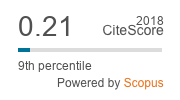Questionário de Situações Domésticas:
Comparação entre Pré-Escolares Clínicos e Não Clínicos
Mots-clés :
Pré-escolares, Problemas comportamentais, Interação pais-filhos, Orientação de paisRésumé
RESUMO - O objetivo deste estudo foi comparar os resultados do Questionário de Situações Domésticas (QSD) respondidos por mães de crianças clínicas e não clínicas, para identificar diferenças no número de situações em que enfrentam problemas de obediência com as crianças e intensidade desses problemas. Foram coletados dados de 56 mães de crianças pré-escolares, entre 3 e 6 anos, com e sem problemas de comportamento opositor. As mães responderam ao Child Behavior Checklist (CBCL), para divisão dos grupos, e ao QSD. O grupo clínico apresentou, em média, 3,2 situações problema a mais que o grupo não clínico, e em média 2,1 pontos a mais na avaliação da severidade. Tais diferenças foram estatisticamente significantes, indicando o QSD como um instrumento sensível no diagnóstico clínico.
Téléchargements
Références
Achenbach, T. M. (2001) Manual for the Child Behavior Checklist/6-18 and 2001 Profile. Burlington: University of Vermont.
Achenbach, T. ., & Rescorla, L. A. (2000). Manual for ASEBA Preschool Forms & Profiles. Burlington: University of Vermont.
Barkley, R. A. (1987). Defiant children: Parent-teacher assignments. New York: Guilford.
Beck, A.T., Russh, A. J., Shaw, B. F., & Emery, G. (1982). Terapia cognitiva da depressão. Rio de Janeiro: Zahar.
Breuer, D., & Dopfner, M. (1997). The assessment of problem situations within family. Praxis der Kinderpsychologie und Kinderpsychiatrie, 46, 583-596.
Brumfield, B. D., & Roberts, M. W. (1998). A comparison of two measurements of child compliance with normal preschool children. Journal of Clinical Child Psychology, 27, 109-116.
Campbell, S. (2002). Behavior problems in preschool children: Clinical and developmental issues (2nd ed.). New York: Guilford.
Catala, A. M., Andres C. M., Gomes B. M., & Agueero, J. A. (1994.). Current validity of Barkley’s criteria for the diagnosis of attention deficit dosorder with hyperactivity. Revista de Psiquiatria Infanto Junenil, 3, 198-202.
Collett B. R., Ohan J. L., & Myers K. M. (2003a). Ten-year review of rating scales, V: Scales assessing attention-deficit/hyperactivity disorder. Journal of the American Academy of Child and Adolescent Psychiatry, 42, 1015-1037.
Collett, B. R., Ohan, J. L., & Myers, K. M. (2003b). Ten-year review of rating scales, VI: Scales assessing externalizing behaviors. Journal of the American Academy of Child and Adolescent Psychiatry, 42, 1143-1170.
Cunha, J. A. (2001). Manual da versão em português das escalas Beck. São Paulo: Casa do Psicólogo.
Eyberg, S. M., & Pincus, D. (1999). Eyberg Child Behavior Inventory and Sutter-Eyberg Student Behavior Inventory-Revised. Professional manual. Odessa: Psychological Assessment Resources.
Forehand, R. (1977). Child noncompliance to parental commands: Behavioral analysis and treatment. Em M. Hersen, R. M. Eisler & P. M. Miller (Eds.), Progress in Behavior Modification, London: Academic Press.
Houlihan, D., Sloane, H. N., Jones, R. N., & Paten, C. (1992). A review of behavioral conceptualizations and treatments of child noncompliance. Education and Treatment of Children, 15, 56-77.
Huang, H. L., Chao, C. C., Tu, C. C., & Yang, P. C. (2003). Behavioral parent training for Taiwanese parents of children with attention-deficit/hyperactivity disorder. Psychiatry and Clinical Neurosciences, 57, 275-281.
Locke, H. J., & Wallace, K. M (1959). Short Marital-Adjustment and Prediction Tests: Their reliability and validity. Mariage and Family Living, 21, 251-255.
Matthey, S., & Barnett, B. (1999). Normative data for an Australian clinical sample on the Home Situations Questionnaire-Modified version (HSQ-M). Behaviour Change, 16, 207-218.
Myers K., & Winters, N. C. (2002). Ten-year review of rating scales II: Scales of internalizing disorders. Journal of the American Academy of Child and Adolescent Psychiatry, 41, 634-659.
Moura, C. B. (2007). Efeitos do vídeo feedback na orientação de mães de pré-escolares com comportamento opositor. Tese de Doutorado. Universidade de São Paulo, SP.
Nixon, R. D. V., Sweeney, L., Ericson, D. B., & Touys, S. W. (2003). Parent-child interation therapy: A comparison of standards and abbreviated treatments for oppositional defiant preschoolers. American Psychological Association, 71, 251-260.
Ohan, J. L., Myers, K., & Collett, B. R. (2002). Ten-year review of rating scales IV: Scales assessing trauma and its effects. Journal of the American Academy of Child and Adolescent Psychiatry, 41, 404-1422.
Patterson, G. R. (1982). Coercive family process. Eugene: Castalia.
Wakschlag, L., & Danis, B. (2004). Assessment of disruptive behavior in young children: A clinical-developmental framework. Em R. Del Carmen-Wiggins & A. S. Carter (Eds.), Handbook of infant, toddler and preschool mental health assessment (pp. 421-440). New York: Oxford University.
Wakschlag, L. S., Leventhal, B. L., Briggs-Gowan, M. J., Danis, B., Keenan, K., Hill, C., Egger, H. L., Cicchetti, D., & Carter, A. S. (2005). Defining the “disruptive” in preschool behavior: What diagnostic observation can teach us. Clinical Child and Family Psychology Review, 8, 183-201.
Winters, N. C., Myers, K., & Proud, L. (2002). Ten-year review of rating scales, III. Scales for suicidality, cognitive style, and self-esteem. Journal of the American Academy of Child and Adolescent Psychiatry, 41,1050-1181.



